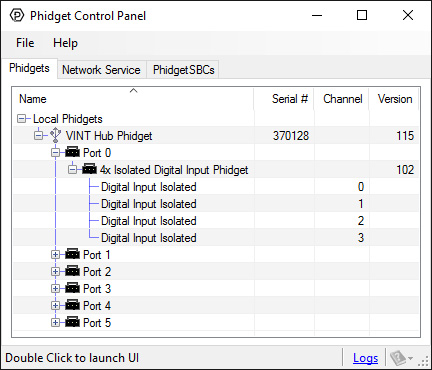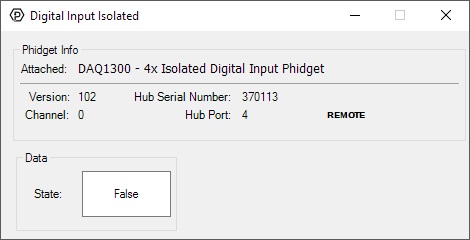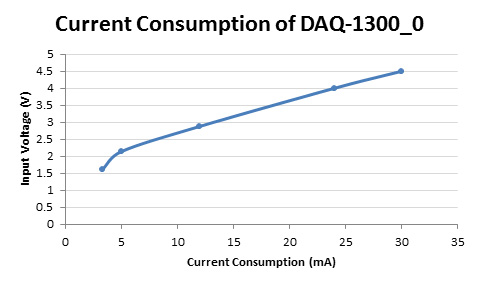DAQ1300 User Guide: Difference between revisions
No edit summary |
No edit summary |
||
| Line 2: | Line 2: | ||
==Getting Started== | ==Getting Started== | ||
{{UGIntro|DAQ1300}} | {{UGIntro|DAQ1300}} | ||
*[{{SERVER}}/products.php?product_id=DAQ1200 DAQ1300 - 4x Isolated Digital Input Phidget] | *[{{SERVER}}/products.php?product_id=DAQ1200 DAQ1300 - 4x Isolated Digital Input Phidget] | ||
* {{VINTHub}} | * {{VINTHub}} | ||
| Line 11: | Line 10: | ||
Next, you will need to connect the pieces: | Next, you will need to connect the pieces: | ||
[[Image:DAQ1300_Functional.jpeg|600px|right|link=]] | |||
# Connect the DAQ1300 to the VINT Hub using the Phidget cable. | # Connect the DAQ1300 to the VINT Hub using the Phidget cable. | ||
# Connect the VINT Hub to your computer with a USB cable. | # Connect the VINT Hub to your computer with a USB cable. | ||
Revision as of 20:59, 19 June 2017
Getting Started
Welcome to the DAQ1300 user guide! In order to get started, make sure you have the following hardware on hand:
- DAQ1300 - 4x Isolated Digital Input Phidget
- VINT Hub
- Phidget cable
- USB cable and computer
- something to use with the DAQ1300 (e.g. switch or digital sensor with a digital output)
Next, you will need to connect the pieces:

- Connect the DAQ1300 to the VINT Hub using the Phidget cable.
- Connect the VINT Hub to your computer with a USB cable.
- Connect a switch or digital sensor to one of the DAQ1300's inputs.
Using the DAQ1300
Phidget Control Panel
In order to demonstrate the functionality of the DAQ1300, the Phidget Control Panel running on a Windows machine will be used.
The Phidget Control Panel is available for use on both macOS and Windows machines.
Windows
To open the Phidget Control Panel on Windows, find the ![]() icon in the taskbar. If it is not there, open up the start menu and search for Phidget Control Panel
icon in the taskbar. If it is not there, open up the start menu and search for Phidget Control Panel
macOS
To open the Phidget Control Panel on macOS, open Finder and navigate to the Phidget Control Panel in the Applications list. Double click on the ![]() icon to bring up the Phidget Control Panel.
icon to bring up the Phidget Control Panel.
For more information, take a look at the getting started guide for your operating system:
Linux users can follow the getting started with Linux guide and continue reading here for more information about the DAQ1300.
First Look
After plugging the DAQ1300 into your computer and opening the Phidget Control Panel, you will see something like this:

The Phidget Control Panel will list all connected Phidgets and associated objects, as well as the following information:
- Serial number: allows you to differentiate between similar Phidgets.
- Channel: allows you to differentiate between similar objects on a Phidget.
- Version number: corresponds to the firmware version your Phidget is running. If your Phidget is listed in red, your firmware is out of date. Update the firmware by double-clicking the entry.
The Phidget Control Panel can also be used to test your device. Double-clicking on an object will open an example.
Digital Input
Double-click on a Digital Input object in order to run the example:

General information about the selected object will be displayed at the top of the window. You can also experiment with the following functionality:
- This is an active-high device, therefore, it will be true when connected to a high voltage, and false when connected to ground.
For more information about Digital Inputs, take a look at the Digital Input Primer
Technical Details
Digital Input Current
The current consumption of this device varies depending on the voltage applied at the input. It ranges from 1.6mA to 4.5mA, according to the curve below:

Further Reading
If you want to know more about the capabilities of the DAQ1300, check the Digital Input Primer.
What to do Next
- Programming Languages - Find your preferred programming language here and learn how to write your own code with Phidgets!
- Phidget Programming Basics - Once you have set up Phidgets to work with your programming environment, we recommend you read our page on to learn the fundamentals of programming with Phidgets.
